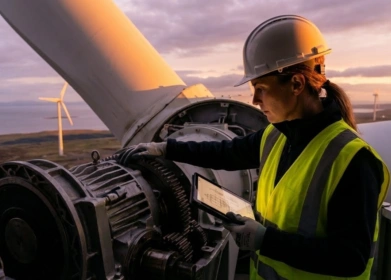What Can You Do With an Aerospace Engineering Degree?
Explore diverse career paths with an aerospace engineering degree. From aircraft design to space missions, discover exciting opportunities and future possibilities.
Jennifer Sheriff

Aerospace engineering is a field that captures the imagination with its blend of science, technology, and innovation. If you're considering pursuing an aerospace engineering degree, you're likely fascinated by the idea of designing aircraft, spacecraft, satellites, and more. But what can you do with an aerospace engineering degree? This article will explore the diverse career paths and opportunities available to aerospace engineering graduates, helping you understand how this degree can shape your future.
1. Design and Development of Aircraft
One of the most direct career paths for aerospace engineering graduates is working in the design and development of aircraft. Aerospace engineers in this field focus on creating new aircraft or improving existing ones. This involves:
Conceptual Design: Engineers work on the initial concepts, creating designs that meet specific requirements and constraints. This includes aerodynamics, propulsion systems, and structural design.
Detailed Design and Analysis: Once a concept is approved, engineers create detailed designs, conduct simulations, and perform structural and performance analyses to ensure safety and efficiency.
Prototyping and Testing: Engineers oversee the construction of prototypes and conduct tests to evaluate performance, safety, and reliability. This involves working with wind tunnels, flight simulators, and other testing facilities.
Career opportunities in aircraft design can be found with major aerospace companies, defense contractors, and research institutions. Companies like Boeing, Airbus, and Lockheed Martin are key players in this sector.
2. Spacecraft and Satellite Engineering
If space exploration excites you, a career in spacecraft and satellite engineering might be a perfect fit. Aerospace engineers in this field work on:
Spacecraft Design: Designing spacecraft for missions ranging from low Earth orbit to deep space exploration. This includes developing systems for propulsion, communication, and thermal control.
Satellite Development: Engineers work on satellites used for communication, weather monitoring, navigation, and scientific research. This involves designing the satellite's structure, electronics, and integration with ground control systems.
Mission Planning and Execution: Engineers plan and oversee space missions, ensuring that spacecraft and satellites operate as intended. This includes managing launch operations, in-space activities, and post-mission analysis.
Organizations like NASA, SpaceX, and the European Space Agency are prominent employers in this field, offering opportunities to work on groundbreaking space missions and technologies.
3. Defense and Military Applications
Aerospace engineering graduates can also pursue careers in defense and military applications. This sector focuses on developing advanced technologies for national security and defense, including:
Military Aircraft Design: Designing and improving fighter jets, transport aircraft, and unmanned aerial vehicles (UAVs) used by the military.
Missile Systems: Developing missile systems, including guidance and control technologies, propulsion, and warhead integration.
Defense Research and Development: Engaging in research and development projects aimed at advancing military capabilities and addressing emerging threats.
Defense contractors such as Raytheon and General Dynamics offer careers in this sector, contributing to national security and technological advancement.
4. Aerospace Systems and Avionics
Aerospace systems and avionics engineers focus on the electronic systems and software that control and monitor aircraft and spacecraft. Key areas include:
Avionics Design: Developing and integrating electronic systems used in aircraft and spacecraft, including navigation, communication, and control systems.
Systems Integration: Ensuring that various systems and components work together seamlessly, from aircraft cockpit systems to spacecraft control systems.
Software Development: Creating software for flight control, navigation, and mission planning. This includes programming and testing software to ensure reliability and performance.
Career opportunities in aerospace systems and avionics can be found with aerospace companies, technology firms, and government agencies.
5. Research and Academia
For those interested in contributing to the field through research and education, a career in academia or research might be appealing. This includes:
Academic Research: Conducting research in aerospace engineering, exploring new technologies, and contributing to scientific knowledge. This often involves publishing research papers and presenting at conferences.
Teaching: Educating the next generation of aerospace engineers by teaching courses at universities and mentoring students in research projects.
Research Institutions: Working with research institutions like the National Institute of Aerospace or private research organizations to advance aerospace technology and knowledge.
Academia and research roles often require advanced degrees (master’s or Ph.D.) and a passion for discovery and education.
6. Consulting and Entrepreneurship
Aerospace engineering graduates can also explore careers in consulting and entrepreneurship. This includes:
Consulting: Providing expert advice to aerospace companies, government agencies, and other organizations. Consultants might work on project management, technology assessments, and strategic planning.
Entrepreneurship: Starting your own aerospace-related business or startup. This could involve developing new technologies, creating innovative solutions, or offering specialized services in the aerospace sector.
Consulting firms and entrepreneurial ventures offer opportunities to leverage your expertise in aerospace engineering and explore new business opportunities.
7. Environmental and Sustainable Technologies
With increasing focus on sustainability, aerospace engineers are also working on developing environmentally friendly technologies. This includes:
Green Aviation: Designing aircraft and propulsion systems that reduce fuel consumption and emissions. This includes research on alternative fuels and energy-efficient technologies.
Space Debris Management: Developing solutions to manage and mitigate space debris, ensuring the long-term sustainability of space activities.
Energy-Efficient Spacecraft: Creating spacecraft and satellite systems that use energy efficiently and minimize environmental impact.
Organizations and research groups focused on environmental sustainability offer opportunities for aerospace engineers to contribute to eco-friendly technologies and practices.
Level Up with an Aerospace Engineering Degree
An aerospace engineering degree opens up a wide range of career opportunities, each offering its own set of challenges and rewards. It’s not the easiest college degree to get, but it’s a rewarding one. From designing cutting-edge aircraft and spacecraft to working on advanced defense technologies, the possibilities are vast and varied. Whether you’re interested in space exploration, defense applications, avionics, or environmental sustainability, an aerospace engineering degree provides a strong foundation for a successful and fulfilling career.
As you consider pursuing an aerospace engineering degree, think about your interests and career goals. Can you afford to spend four years for a Bachelor’s or two years for a Master’s in Aerospace Engineering? The field offers exciting opportunities to work on innovative projects, solve complex problems, and contribute to technological advancements that impact the world. With dedication and a passion for aerospace technology, you can embark on a career that not only challenges you but also allows you to make a significant impact in the world of engineering.
Related Articles

How to Pivot Your Career: The Masters in Mechanical Engineering Roadmap
The core principles of mechanical engineering are timeless, yet their applications are constantly expanding. The rise of automation, the urgency of climate change, and the explosion of data have created new frontiers where mechanical engineers are uniquely positioned to make a significant impact. Staying relevant and seizing these opportunities often requires a deeper, more specialized skill set than what an undergraduate degree can provide.
Read More
The Best Online Engineering Degrees for Explosive Career Growth & High ROI
The rise of accredited, rigorous online engineering degrees has created an unprecedented opportunity to gain elite skills, accelerate career growth, and achieve a remarkable return on investment—all on your own terms. This article is designed to cut through the noise. We will explore the specific online engineering disciplines that offer explosive career growth, delve into what a high ROI truly means in this field, and provide a clear roadmap for selecting and financing a program that aligns perfectly with your ambitions.
Read More
How Long Does an Aerospace Engineering Degree Take?
Explore how long it takes to earn an aerospace engineering degree. Learn about the duration of Bachelor’s, Master’s, and Ph.D. programs to plan your educational path.
Read More